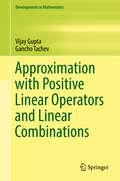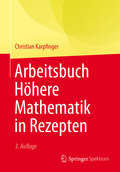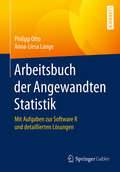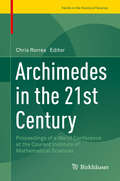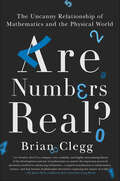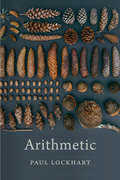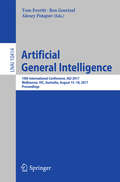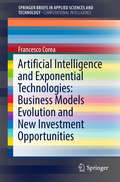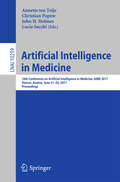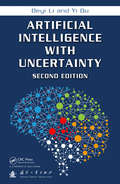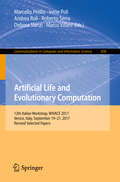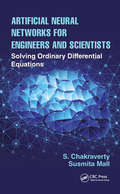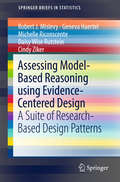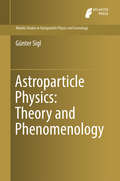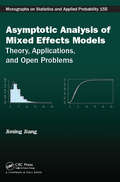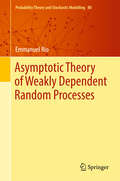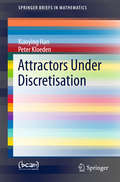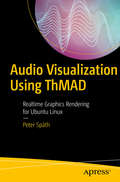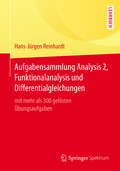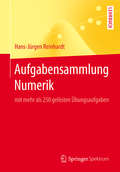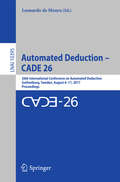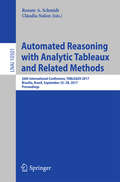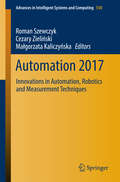- Table View
- List View
Approximation und Nichtlineare Optimierung in Praxisaufgaben: Anwendungen aus dem Finanzbereich und der Standortplanung (Studienbücher Wirtschaftsmathematik)
by Christiane Tammer Alfred Göpfert Thomas RiedrichIn diesem Buch wird die Vielgestaltigkeit von Optimierung und Approximation zusammen mit ihrem breiten Umfeld anhand von Aufgaben samt ihren L#65533;sungen und interpretierenden Aussagen zum Ausdruck gebracht. Fachlich steht dabei im Vordergrund, Methoden der Angewandten Analysis zu nutzen, um die Struktur und Eigenschaften der Probleme zu erkennen und handhabbare Optimalit#65533;tbedingungen herzuleiten, die die Behandlung der Aufgaben erm#65533;glichen und vereinfachen. Viele praktische Aufgabenstellungen f#65533;hren auf konvexe bzw. nichtkonvexe Optimierungsprobleme, Mehrkriterielle Optimierungsprobleme, Standortprobleme, Probleme der Risikotheorie, Versicherungsmathematik, Robuste Probleme und Signaltheorie, die in den vorgestellten Aufgaben diskutiert werden. Hinweise auf online-verf#65533;gbare Software werden gegeben. Das Buch richtet sich an Studierende der Wirtschaftsmathematik im Masterstudium.
Approximation with Positive Linear Operators and Linear Combinations (Developments in Mathematics #50)
by Vijay Gupta Gancho TachevThis book presents a systematic overview of approximation by linear combinations of positive linear operators, a useful tool used to increase the order of approximation. Fundamental and recent results from the past decade are described with their corresponding proofs. The volume consists of eight chapters that provide detailed insight into the representation of monomials of the operators Ln , direct and inverse estimates for a broad class of positive linear operators, and case studies involving finite and unbounded intervals of real and complex functions. Strong converse inequalities of Type A in terminology of Ditzian-Ivanov for linear combinations of Bernstein and Bernstein-Kantorovich operators and various Voronovskaja-type estimates for some linear combinations are analyzed and explained. Graduate students and researchers in approximation theory will find the list of open problems in approximation of linear combinations useful. The book serves as a reference for graduate and postgraduate courses as well as a basis for future study and development.
Arbeitsbuch Höhere Mathematik in Rezepten
by Christian KarpfingerIn diesem Buch stellen wir die mehr als 500 Aufgaben des Lehrbuchs Höhere Mathematik in Rezepten (dritte Auflage) des gleichen Autors mit Lösungen zusammen.<P><P> Sie haben die Gelegenheit, die Rezepte des Rezeptebuchs zum Lösen typischer Aufgabenstellungen der Höheren Mathematik bei vielen Beispielen anzuwenden. Wir bieten auch zahlreiche Aufgaben zum Nachdenken und Knobeln an, die das tiefere Verständnis für Mathematik fördern. Nicht zuletzt findet man auch einige Programmieraufgaben, mit deren Lösungen Sie in der Lage sind, zahlreiche Aufgabenstellungen zu bearbeiten, mit denen Sie im Laufe Ihres Studiums bzw. Berufslebens konfrontiert sein werden.<P> Behandelt werden alle Themen, die üblicherweise in vier Semestern Höhere Mathematik unterrichtet werden. Im Einzelnen sind dies Analysis einer und mehrerer Variabler, lineare Algebra, Vektoranalysis, Differenzialgleichungen (gewöhnliche und partielle), Integraltransformationen und Funktionentheorie. In der vorliegenden dritten Auflage des Arbeitsbuchs sind die Aufgaben und Lösungen an die dritte Auflage des Hauptwerks angepasst.
Arbeitsbuch der Angewandten Statistik: Mit Aufgaben zur Software R und detaillierten Lösungen
by Philipp Otto Anna-Liesa LangeDas Arbeitsbuch stellt eine Aufgabensammlung mit detaillierten L#65533;sungen zur Einf#65533;hrung in die Angewandte Statistik f#65533;r Studenten zur Verf#65533;gung. Die Aufgaben umfassen dabei die Themengebiete, welche in etwa in drei Semestern Statistikausbildung gelehrt werden. Damit ist das Arbeitsbuch insbesondere f#65533;r Studierende der Wirtschaftswissenschaften, Humanmedizin, Psychologie, Ingenieurswissenschaften sowie Informatik von Interesse. Insgesamt wird durch interessante, teilweise reale und teilweise fiktive Sachverhalte das Lernen des ansonsten eher trockenen vermittelten Stoffes erleichtert. Praktische Aufgaben, die mithilfe der Statistiksoftware R gel#65533;st werden m#65533;ssen, sind besonders gekennzeichnet. Am Ende des Buches gibt es Aufgaben zu gemischten Themengebieten zur Klausurvorbereitung.
Archimedes in the 21st Century: Proceedings of a World Conference at the Courant Institute of Mathematical Sciences (Trends in the History of Science)
by Chris RorresThis book is a collection of papers presented at the "Archimedes in the 21st Century" world conference, held at the Courant Institute of Mathematical Sciences in 2013. This conference focused on the enduring and continuing influence of Archimedes in our modern world, celebrating his centuries of influence on mathematics, science, and engineering. Archimedes planted the seeds for a myriad of seminal ideas that would grow over the ages. Each chapter surveys the growth of one or more of these seeds, and the fruit that they continue to bear to this day. The conference speakers contributing to this book are actively involved in STEM fields whose origins trace back to Archimedes, many of whom have conducted and published research that extends Archimedes' work into the 21st century. The speakers are not historians, so while historical context is provided, this book is uniquely focused on the works themselves as opposed to their history. The breadth and depth of Archimedes' influence will inspire, delight, and even surprise readers from a variety of fields and interests including historians, mathematicians, scientists, and engineers. Only a modest background in math is required to read this book, making it accessible to curious readers of all ages.
Are Numbers Real?: The Uncanny Relationship of Mathematics and the Physical World
by Brian Clegg“A lighthearted yet far-reaching look at the history of numbers and how we use them.” —Publishers WeeklyHave you ever wondered what humans did before numbers existed? How they organized their lives, traded goods, or kept track of their treasures? What would your life be like without them?Numbers began as simple representations of everyday things, but mathematics rapidly took on a life of its own, occupying a parallel virtual world. In Are Numbers Real?, Brian Clegg explores the way that math has become more and more detached from reality, and yet despite this is driving the development of modern physics. From devising a new counting system based on goats, through the weird and wonderful mathematics of imaginary numbers and infinity, to the debate over whether mathematics has too much influence on the direction of science, this fascinating and accessible book opens the reader’s eyes to the hidden reality of the strange yet familiar entities that are numbers.Praise for Are Numbers Real?“A compact, very readable, and highly entertaining history of the development and use of mathematics to answer the important practical questions involved in advancing civilization . . . a superb introduction to mathematics, science, and that branch of philosophy devoted to exploring the nature of reality.” —Dr. James Stein, California State University, Long Beach“Clegg tackles a very deep question in his usual way; with clarity, wit and a wonderfully clear narrative writing style. For me, numbers are like natural language: They obviously don’t exist in a physical sense—you cannot trip over the number 2 in the street—yet numbers are at the heart of understanding the universe. Clegg covers a wide variety of subjects to seek out the truth of the matter in an engaging and hugely accessible way. I personally couldn’t put it down.” —Dr. Peet Morris, University of Oxford
Arithmetic
by Paul LockhartPaul Lockhart reveals arithmetic not as the rote manipulation of numbers but as a set of ideas that exhibit the surprising behaviors usually reserved for higher branches of mathematics. In this entertaining survey, he explores the nature of counting and different number systems—Western and non-Western—and weighs the pluses and minuses of each.
Arithmetische Funktionen
by Paul J. MccarthyDieses Buch bietet eine Einf#65533;hrung in die Theorie der arithmetischen Funktionen, welche zu den klassischen und dynamischen Gebieten der Zahlentheorie geh#65533;rt. Das Buch enth#65533;lt breitgef#65533;cherte Resultate, die f#65533;r alle mit den Grundlagen der Zahlentheorie vertrauten Leser zug#65533;nglich sind. Der Inhalt geht weit #65533;ber das Spektrum hinaus, mit dem die meisten Lehrb#65533;cher dieses Thema behandeln. Intensiv besprochen werden beispielsweise Ramanujan-Summen, Fourier-Zerlegungen arithmetischer Funktionen, Anzahl der L#65533;sungen von Kongruenzen, Dirichlet-Reihen und verallgemeinerte Dirichlet-Faltungen sowie arithmetische Funktionen auf Gittern. Desweiteren sind viele bibliografische Anmerkungen sowie Verweise auf Originalliteratur aufgef#65533;hrt. Mehr als 400 #65533;bungsaufgaben bilden dar#65533;ber hinaus einen wesentlichen Bestandteil f#65533;r die Erschlie#65533;ung des Themas.
Artificial General Intelligence: 10th International Conference, AGI 2017, Melbourne, VIC, Australia, August 15-18, 2017, Proceedings (Lecture Notes in Computer Science #10414)
by Tom Everitt, Ben Goertzel and Alexey PotapovThis book constitutes the proceedings of the 10th International Conference on Artificial General Intelligence, AGI 2017, held in Melbourne, VIC, Australia, in August 2017. The 24 regular papers presented in this book together with 1 short paper were carefully reviewed and selected from 35 submissions. They cover topics such as architectures; mathematical foundations; algorithms; safety; understanding; human cognition; and philosophy.
Artificial Intelligence and Exponential Technologies: Business Models Evolution and New Investment Opportunities (SpringerBriefs in Applied Sciences and Technology)
by Francesco CoreaArtificial Intelligence is a huge breakthrough technology that is changing our world. It requires some degrees of technical skills to be developed and understood, so in this book we are going to first of all define AI and categorize it with a non-technical language. We will explain how we reached this phase and what historically happened to artificial intelligence in the last century. Recent advancements in machine learning, neuroscience, and artificial intelligence technology will be addressed, and new business models introduced for and by artificial intelligence research will be analyzed. Finally, we will describe the investment landscape, through the quite comprehensive study of almost 14,000 AI companies and we will discuss important features and characteristics of both AI investors as well as investments. This is the "Internet of Thinks" era. AI is revolutionizing the world we live in. It is augmenting the human experiences, and it targets to amplify human intelligence in a future not so distant from today. Although AI can change our lives, it comes also with some responsibilities. We need to start thinking about how to properly design an AI engine for specific purposes, as well as how to control it (and perhaps switch it off if needed). And above all, we need to start trusting our technology, and its ability to reach an effective and smart decision.
Artificial Intelligence in Medicine: 16th Conference on Artificial Intelligence in Medicine, AIME 2017, Vienna, Austria, June 21-24, 2017, Proceedings (Lecture Notes in Computer Science #10259)
by Annette ten Teije, Christian Popow, John H. Holmes and Lucia SacchiThis book constitutes the refereed proceedings of the 16th Conference on Artificial Intelligence in Medicine, AIME 2017, held in Vienna, Austria, in June 2017.The 21 revised full and 23 short papers presented were carefully reviewed and selected from 113 submissions. The papers are organized in the following topical sections: ontologies and knowledge representation; Bayesian methods; temporal methods; natural language processing; health care processes; and machine learning, and a section with demo papers.
Artificial Intelligence with Uncertainty
by Yi Du Deyi LiThis book develops a framework that shows how uncertainty in Artificial Intelligence (AI) expands and generalizes traditional AI. It explores the uncertainties of knowledge and intelligence. The authors focus on the importance of natural language – the carrier of knowledge and intelligence, and introduce efficient physical methods for data mining amd control. In this new edition, we have more in-depth description of the models and methods, of which the mathematical properties are proved strictly which make these theories and methods more complete. The authors also highlight their latest research results.
Artificial Life and Evolutionary Computation: 12th Italian Workshop, WIVACE 2017, Venice, Italy, September 19-21, 2017, Revised Selected Papers (Communications In Computer And Information Science #830)
by Irene Poli Marcello Pelillo Marco Villani Roberto Serra Andrea Roli Debora SlanziThis book constitutes the revised selected papers of the 12th Italian Workshop on Advances in Artificial Life, Evolutionary Computation, WIVACE 2017, held in Venice, Italy, in September 2017.The 23 full papers presented were thoroughly reviewed and selected from 33 submissions. They cover the following topics: physical-chemical phenomena; biological systems; economy and society; complexity; optimization.
Artificial Neural Networks for Engineers and Scientists: Solving Ordinary Differential Equations
by S. Chakraverty Susmita MallDifferential equations play a vital role in the fields of engineering and science. Problems in engineering and science can be modeled using ordinary or partial differential equations. Analytical solutions of differential equations may not be obtained easily, so numerical methods have been developed to handle them. Machine intelligence methods, such as Artificial Neural Networks (ANN), are being used to solve differential equations, and these methods are presented in Artificial Neural Networks for Engineers and Scientists: Solving Ordinary Differential Equations. This book shows how computation of differential equation becomes faster once the ANN model is properly developed and applied.
Assessing Model-Based Reasoning using Evidence- Centered Design: A Suite of Research-Based Design Patterns (SpringerBriefs in Statistics)
by Robert J Mislevy Geneva Haertel Michelle Riconscente Daisy Wise Rutstein Cindy ZikerThis Springer Brief provides theory, practical guidance, and support tools to help designers create complex, valid assessment tasks for hard-to-measure, yet crucial, science education standards. Understanding, exploring, and interacting with the world through models characterizes science in all its branches and at all levels of education. Model-based reasoning is central to science education and thus science assessment. Current interest in developing and using models has increased with the release of the Next Generation Science Standards, which identified this as one of the eight practices of science and engineering. However, the interactive, complex, and often technology-based tasks that are needed to assess model-based reasoning in its fullest forms are difficult to develop. Building on research in assessment, science education, and learning science, this Brief describes a suite of design patterns that can help assessment designers, researchers, and teachers create tasks for assessing aspects of model-based reasoning: Model Formation, Model Use, Model Elaboration, Model Articulation, Model Evaluation, Model Revision, and Model-Based Inquiry. Each design pattern lays out considerations concerning targeted knowledge and ways of capturing and evaluating students' work. These design patterns are available at http://design-drk. padi. sri. com/padi/do/NodeAction'state=listNodes&NODE_TYPE=PARADIGM_TYPE. The ideas are illustrated with examples from existing assessments and the research literature.
Astroparticle Physics: Theory and Phenomenology (Atlantis Studies in Astroparticle Physics and Cosmology #1)
by Günter SiglThis books aims at giving an overview over theoretical and phenomenological aspects of particle astrophysics and particle cosmology. To be of interest for both students and researchers in neighboring fields of physics, it keeps a balance between well established foundations that will not significantly change in the future and a more in-depth treatment of selected subfields in which significant new developments have been taking place recently. These include high energy particle astrophysics, such as cosmic high energy neutrinos, the interplay between detection techniques of dark matter in the laboratory and in high energy cosmic radiation, axion-like particles, and relics of the early Universe such as primordial magnetic fields and gravitational waves. It also contains exercises and thus will be suitable for both introductory and advanced courses in astroparticle physics.
Asymptotic Analysis of Mixed Effects Models: Theory, Applications, and Open Problems (Chapman & Hall/CRC Monographs on Statistics and Applied Probability)
by Jiming JiangLarge sample techniques are fundamental to all fields of statistics. Mixed effects models, including linear mixed models, generalized linear mixed models, non-linear mixed effects models, and non-parametric mixed effects models are complex models, yet, these models are extensively used in practice. This monograph provides a comprehensive account of asymptotic analysis of mixed effects models. The monograph is suitable for researchers and graduate students who wish to learn about asymptotic tools and research problems in mixed effects models. It may also be used as a reference book for a graduate-level course on mixed effects models, or asymptotic analysis.
Asymptotic Theory of Weakly Dependent Random Processes (Probability Theory and Stochastic Modelling #80)
by Emmanuel RioCes notes sont consacr#65533;es aux in#65533;galit#65533;s et aux th#65533;or#65533;mes limites classiques pour les suites de variables al#65533;atoires absolument r#65533;guli#65533;res ou fortement m#65533;langeantes au sens de Rosenblatt. Le but poursuivi est de donner des outils techniques pour l'#65533;tude des processus faiblement d#65533;pendants aux statisticiens ou aux probabilistes travaillant sur ces processus.
Attractors Under Discretisation (SpringerBriefs in Mathematics)
by Peter Kloeden Xiaoying HanThis work focuses on the preservation of attractors and saddle points of ordinary differential equations under discretisation. In the 1980s, key results for autonomous ordinary differential equations were obtained - by Beyn for saddle points and by Kloeden & Lorenz for attractors. One-step numerical schemes with a constant step size were considered, so the resulting discrete time dynamical system was also autonomous. One of the aims of this book is to present new findings on the discretisation of dissipative nonautonomous dynamical systems that have been obtained in recent years, and in particular to examine the properties of nonautonomous omega limit sets and their approximations by numerical schemes - results that are also of importance for autonomous systems approximated by a numerical scheme with variable time steps, thus by a discrete time nonautonomous dynamical system.
Audio Visualization Using ThMAD
by Peter SpäthLearn how to use Thinking Machine Audio Dreams (ThMAD), a realtime audio visualization engine for Ubuntu Linux. This book bridges the gap between programmers and artists. Both artists and developers with an inclination towards arts will profit from this book since it is a combination of a hands-on tutorial, manual, and reference, with many illustrations that accompany the explanations and tutorials.You'll learn the basics of ThMAD's open source software suite and then start experimenting and building your own rendering pipelines to create audio visualizations. You'll see how to soundly use all ThMAD's GUI functionalities, and all modules are provided in a way that will serve both intellectual curiosity and professional needs. The examples that are used as part of the software, and the tutorials included in the book, will serve as a solid basis for your own experiments.What You'll LearnUse the ThMAD software, all GUI functionalities, and all modulesDevelop your own audio visualization projectsExplore the program operations for ThMAD Artiste and ThMAD Player, including all possible options for controlling program operations.Who This Book Is ForVisual artists with some IT background, or developers with artistic inclinations. Development experience is not required, but surely helpful.
Aufgabensammlung Analysis 2, Funktionalanalysis und Differentialgleichungen: mit mehr als 300 gelösten Übungsaufgaben
by Hans-Jürgen ReinhardtSie suchen #65533;bungen zur Klausurvorbereitung, Material f#65533;r Tutorien oder Beispiele f#65533;r eine Vorlesung zur weiterf#65533;hrenden Analysis? In diesem umfangreichen Buch finden Sie eine Vielzahl verschiedener Aufgaben - von abstrakten Beweisen #65533;ber theoretische und angewandte Beispiele hin zu konkreten Berechnungen. Zur #65533;berpr#65533;fung der eigenen Arbeit gibt es ausf#65533;hrliche L#65533;sungen zu jeder Aufgabe. Somit ist das vorliegende Werk das ideale Begleitbuch sowohl f#65533;r Studierende als auch f#65533;r Dozenten der Mathematik. Die Zusammenstellung von #65533;bungsaufgaben entstand w#65533;hrend der entsprechenden Vorlesungen des Autors an der Universit#65533;t Siegen in den Jahren 1993 bis 2013.
Aufgabensammlung Numerik
by Hans-Jürgen ReinhardtDiese Aufgabensammlung zur Numerik des Bachelor- und Masterstudiums ist das ideale Begleitbuch sowohl für Studierende als auch für Dozenten der Mathematik.Suchen Sie Übungen zur Klausurvorbereitung oder Beispiele für Ihre Vorlesung? Dieses umfangreiche Buch deckt das gesamte Themenspektrum der Numerik ab – von den Grundlagen über gewöhnliche und partielle Differentialgleichungen bis hin zur Methode der Finiten Elemente. Dabei umfasst die Art der Aufgaben sowohl theoretische Beweise wie auch konkrete Berechnungen ab. Zur Überprüfung der eigenen Arbeit gibt es ausführliche Lösungen zu jeder Aufgabe.Die Zusammenstellung von Übungsaufgaben entstand während der entsprechenden Vorlesungen des Autors an der Universität Siegen in den Jahren 1989 bis 2015.
Automated Deduction – CADE 26: 26th International Conference on Automated Deduction, Gothenburg, Sweden, August 6–11, 2017, Proceedings (Lecture Notes in Computer Science #10395)
by Leonardo MouraThis book constitutes the proceeding of the 26th International Conference on Automated Deduction, CADE-26, held in Gothenburg, Sweden, in August 2017. The 26 full papers and 5 system descriptions presented were carefully reviewed and selected from 69 submissions. CADE is the major forum for the presentation of research in all aspects of automated deduction, including foundations, applications, implementations and practical experience. The chapter 'Certifying Confluence of Quasi-Decreasing Strongly Deterministic Conditional Term Rewrite Systems' is published open access under a CC BY 4. 0 license.
Automated Reasoning with Analytic Tableaux and Related Methods: 26th International Conference, TABLEAUX 2017, Brasília, Brazil, September 25–28, 2017, Proceedings (Lecture Notes in Computer Science #10501)
by Renate A. Schmidt Cláudia NalonThis book contains the proceedings of the 26th International Conference on Automated Reasoning with Analytics Tableaux and Related Methods, TABLEAUX 2017, held in Bras#65533;lia, Bazil, in September 2017. The 19 contributed papers presented in this volume were carefully reviewed and selected from 27 submissions. They are organized in topical sections named: Sequent systems; tableaux; transitive closure and cyclic proofs; formalization and complexity. Also included are papers of three invited speakers.
Automation 2017: Innovations in Automation, Robotics and Measurement Techniques (Advances in Intelligent Systems and Computing #550)
by Roman Szewczyk Małgorzata Kaliczyńska Cezary ZielińskiThis book consists of papers presented at Automation 2017, an international conference held in Warsaw from March 15 to 17, 2017. It discusses research findings associated with the concepts behind INDUSTRY 4. 0, with a focus on offering a better understanding of and promoting participation in the Fourth Industrial Revolution. Each chapter presents a detailed analysis of a specific technical problem, in most cases followed by a numerical analysis, simulation and description of the results of implementing the solution in a real-world context. The theoretical results, practical solutions and guidelines presented are valuable for both researchers working in the area of engineering sciences and practitioners looking for solutions to industrial problems.

